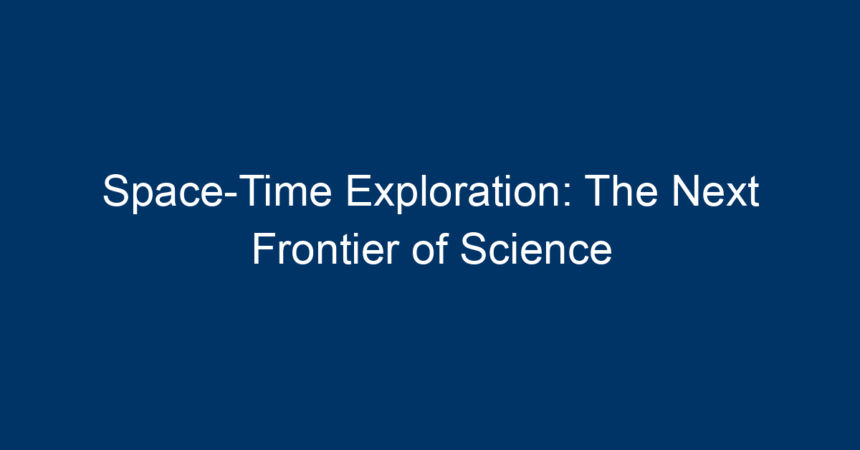Introduction
In the ever-evolving landscape of scientific inquiry, space-time exploration stands out as an exhilarating frontier. As we venture deeper into the cosmos, our understanding of the fabric of space and time challenges everything we thought we knew about reality. This article will delve into the fascinating realm of space-time exploration, examining the theories, technologies, and potential discoveries that may reshape our perception of the universe and our place within it.
Understanding Space-Time
What is Space-Time?
At its core, space-time is a four-dimensional continuum that blends the three dimensions of space with the dimension of time. Historically, this concept emerged from Albert Einstein’s theories of relativity. In simple terms, space-time suggests that the universe is not merely a vast expanse but a complex interwoven tapestry that shapes how we perceive gravitational forces and the movement of celestial bodies.
The Importance of Space-Time in Physics
Space-time is fundamental to modern physics, guiding our understanding of gravitation, cosmology, and quantum mechanics. When we probe deeper into the origins of the universe, we are essentially exploring the interplay between space and time, as these dimensions impact everything from black holes to the ripple effects of gravitational waves.
Theoretical Frameworks Driving Space-Time Exploration
General Relativity and Quantum Mechanics
General relativity provides a macroscopic view of space-time, elucidating how mass and energy warp this continuum. On the other hand, quantum mechanics offers insight into the behavior of particles at micro levels. The juxtaposition of these two theories presents a significant challenge in physics, as they often conflict. Uniting them into a cohesive framework would revolutionize our approach to space-time exploration.
String Theory and Loop Quantum Gravity
Beyond general relativity and quantum mechanics, theories such as string theory and loop quantum gravity aim to bridge the gap between the cosmic and the atomic. String theory posits that fundamental particles are not points but rather tiny vibrating strings, inherently tied to the fabric of space-time. Loop quantum gravity, meanwhile, suggests that space-time itself may be quantized, composed of discrete loops rather than a continuous expanse. Both theories fuel debates around the nature of reality, invigorating the quest for deeper understanding through space-time exploration.
Technological Advancements in Space-Time Research
Breakthrough Experiments and Observations
Recent advancements in technology have significantly propelled space-time exploration. Projects like the Laser Interferometer Gravitational-Wave Observatory (LIGO) have allowed scientists to detect gravitational waves, confirming predictions made by Einstein and opening a new window into the universe’s most violent events, like merging black holes. Such milestones represent not just technological triumphs; they are monumental steps toward unraveling the mysteries of space-time.
Quantum Computing and Simulation
Quantum computing holds immense potential for computational models that explore complex theories in space-time exploration. Unlike classical computers, quantum computers can process vast amounts of data simultaneously, making them ideal for simulating conditions in space-time that are otherwise inaccessible. As we rethink what is possible, these advancements promise to substantially enhance our understanding of the universe.
The Role of Space-Time Exploration in Cosmology
The Big Bang and Cosmic Evolution
Space-time exploration has profound implications for our understanding of the universe’s origins. The Big Bang theory proposes that the universe began as an infinitely dense point, subsequently expanding and evolving over billions of years. By studying cosmic microwave background radiation and other astronomical phenomena, researchers strive to reconstruct the early moments of our universe and how they influenced the fabric of space and time.
Dark Matter and Dark Energy
As we delve further into space-time, we face the enigma of dark matter and dark energy, which together constitute about 95% of the universe. Understanding their roles in the expansion of the universe necessitates an exploration of space-time’s architecture. Advanced telescopes and space missions continue to gather data that may one day illuminate these cosmic mysteries.
Challenges and Ethical Considerations
The Complexity of Space-Time
Despite the excitement surrounding space-time exploration, the complexity of the concepts and the interplay of various dimensions often present significant challenges. Misinterpretations and oversimplifications can lead to confusion and skepticism in the public domain. Thus, it is crucial for scientists to communicate their findings effectively.
Ethical Implications
As we explore space-time, ethical considerations come into play. The quest for deeper knowledge often involves advanced technologies that may have unintended consequences, such as the potential for weaponization of scientific discoveries. Collaborative international efforts and regulations should guide the responsible exploration of space-time.
Future Prospects in Space-Time Exploration
Predictive Models and Artificial Intelligence
The intersection of artificial intelligence (AI) and space-time exploration holds exciting prospects. AI can analyze massive datasets, identify patterns, and even generate predictive models for future cosmic phenomena. This synergy will enhance our understanding and enable us to make informed predictions about the universe.
Interstellar Travel and the Fabric of Space-Time
One of the most tantalizing prospects in space-time exploration is the potential for interstellar travel. Concepts like wormholes and warp drives, while currently theoretical, highlight a future where humanity might transcend beyond our solar system. By unraveling the mysteries of space-time, these concepts may one day transform from science fiction into reality.
Conclusion: The Call to Action
As we stand on the brink of profound discoveries, space-time exploration beckons a collective effort. It invites scientists, technologists, and enthusiasts alike to engage in this journey through collaboration, education, and awareness. By fostering discussions and encouraging interdisciplinary initiatives, we can collectively navigate the fabric of our universe.
This is not just a scientific debate; it is a human endeavor that transcends borders and ideologies. With proper investment in research and technology, our pursuit of space-time exploration might lead to breakthroughs that not only redefine our understanding of the cosmos but also our existence within it. Every inquiry, every milestone achieved, brings humanity closer to the stars—let us embark on this journey together.
Final Thoughts
The field of space-time exploration is a testament to human curiosity and the unyielding desire to understand the universe. As we embrace this scientific odyssey, we pave the way for future generations to discover and unravel the mysteries that lie beyond our current comprehension. Together, we can truly explore the next frontier of science.




